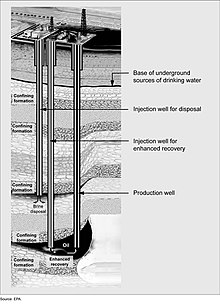Produced water

Produced water is a term used in the oil industry to describe water that is produced as a byproduct during the extraction of oil and natural gas. Produced water is a kind of brackish and saline waters from under ground formation that are brought to the surface.[1] Oil and gas reservoirs often have water as well as hydrocarbons, sometimes in a zone that lies under the hydrocarbons, and sometimes in the same zone with the oil and gas.
Oil wells sometimes produce large volumes of water with the oil, while gas wells tend to produce water in smaller proportion.
To achieve maximum oil recovery, waterflooding is often implemented, in which water is injected into the reservoirs to help force the oil to the production wells. The injected water eventually reaches the production wells, and so in the later stages of waterflooding, the produced water proportion ("cut") of the total production increases.
Water quality[]
The water composition ranges widely from well to well and even over the life of the same well. Much produced water is brine, and most formations result in total dissolved solids too high for beneficial reuse. All produced water contains oil and suspended solids.[citation needed] Some produced water contains heavy metals and traces of naturally occurring radioactive material (NORM), which over time deposits radioactive scale in the piping at the well.[2][3] Metals found in produced water include zinc, lead, manganese, iron, and barium.[4]: 8
Water management[]

Historically, produced water was disposed of in large evaporation ponds. However, this has become an increasingly unacceptable disposal method from both environmental and social perspectives. Produced water is considered an industrial waste.
The broad management options for re-use are direct injection, environmentally acceptable direct-use of untreated water, or treatment to a government-issued standard before disposal or supply to users. Treatment requirements vary throughout the world. In the United States these standards are issued by the U.S. Environmental Protection Agency (EPA) for underground injection[5][6] and discharges to surface waters.[7] Although beneficial reuse for drinking water and agriculture have been researched, the industry has not adopted these measures due to cost, water availability, and social acceptance.[citation needed]
Gravity separators, hydrocyclones, plate coalescers, dissolved gas flotation, and nut shell filters are some of the technologies used in treating wastes from produced water.[8]
Radioactivity[]
In January, 2020, Rolling Stone magazine published an extensive report regarding produced water's radioactivity contents and its effects on workers and communities across the United States.[9] Per the article, sampled brine from a plant in Ohio, tested in a University of Pittsburgh lab, registered radium levels above 3,500. The Nuclear Regulatory Commission requires industrial discharges to remain below 60 for each of the most common isotopes of radium, radium-226 and radium-228.
See also[]
- Industrial waste water treatment
- Oil–water separator
References[]
- ^ D. Atoufi, Hossein; Lampert, David J. (2020). "Impacts of Oil and Gas Production on Contaminant Levels in Sediments". Current Pollution Reports. 6 (2): 43–53. doi:10.1007/s40726-020-00137-5. ISSN 2198-6592 – via Springer Nature.
- ^ "About Produced Water". Advanced Water Technology Center. Golden, CO: Colorado School of Mines. Retrieved 2016-05-14.
- ^ Igunnu, Ebenezer T.; Chen, George Z. (September 2014). "Produced water treatment technologies". International Journal of Low-Carbon Technologies. 9 (3): 157–177. doi:10.1093/ijlct/cts049.
- ^ Veil, John A.; Puder, Markus G.; Elcock, Deborah; Redweik, Robert J. (2004). A white paper describing produced water from production of crude oil, natural gas, and coal bed methane (PDF) (Report). Argonne, IL: US Argonne National Laboratory. ANL/EA/RP-112631.
- ^ "Underground Injection Control Regulations and Safe Drinking Water Act Provisions". Washington, DC: U.S. Environmental Protection Agency (EPA). 2016-10-17.
- ^ "General Information About Injection Wells". EPA. 2016-09-06.
- ^ "Oil and Gas Extraction Effluent Guidelines". EPA. 2019-05-15.
- ^ Development Document for Final Effluent Limitations Guidelines and New Source Performance Standards for the Offshore Subcategory of the Oil and Gas Extraction Point Source Category (Report). EPA. 1993. pp. IX-15–IX-19. EPA-821-R-93-003.
- ^ https://www.rollingstone.com/politics/politics-features/oil-gas-fracking-radioactive-investigation-937389/
- Petroleum production
- Water pollution
- Natural gas